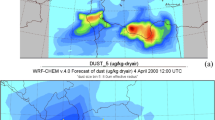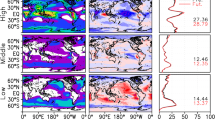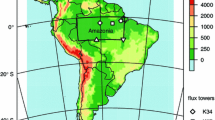Summary
In recent years many studies have shown the importance of treating condensation processes in a consistent manner in numerical weather prediction models. Among emerging improvements is the explicit treatment of cloud water, and in some cases precipitating water. An unresolved problem then is how to initialize the cloud water, especially since this quantity is not treated in the most commonly used analysis schemes.
In this study, a method for initializing the cloud water in a numerical weather prediction (NWP) model will be presented and tested. The implications for the model's spin-up are investigated. Information from an earlier run (“first guess fields”) is used, together with satellite data. If necessary, humidity enhancement is performed where clouds are indicated by those sources. The results indicate that initialization of the cloud water field by itself does not have a large effect on the spin-up of precipitation and clouds. A much larger effect is obtained when the humidity field is enhanced. The spin-up time for precipitation is then reduced from 12 to 6 hours, while for cloud cover it is reduced to only 1–2 hours. The method is computationally very efficient, and is particularly useful over data-sparse areas, such as the oceans.
An investigation of the different terms in the cloud water tendency equation is done and the results interpreted in terms of spin-up of cloud parameters. These tests confirm that the cloud water field only accounts for a small part of the spin-up effect. These also show that the production of cloud water per time step increases throughout the simulation.
Similar content being viewed by others
References
Berge, E., Kristjánsson, J. E., 1992: Numerical weather simulations with different formulations for the advection of humidity and cloud water.Mon. Wea. Rev.,120, 1583–1602.
Bratseth, A., 1982: A simple and efficient approach to the initialization of weather prediction models.Tellus.34, 352–357.
Danard, M., 1985: On the use of satellite estimates of precipitation in initial analyses for numerical weather prediction.Atmos. Ocean,23, 23–42.
Huang, X.-Y., Lynch, P., 1992: Diabatic digital filtering initialization: An application to the HIRLAM model.Mon. Wea. Rev. (accepted).
Lynch, P., Huang, X.-Y., 1992: Initialization of the HIRLAM model using a digital filter.Mon. Wea. Rev.,120, 1019–1034.
Nordeng, T. E., Rasmussen, E., 1992: A most beautiful polar low. A case study of a polar low development in the Bear Island region.Tellus,44A, 81–99.
Parrish, D. F., Derber, J. C., 1992: The National Meteorological Center's spectral statistical interpolation analysis system.Mon. Wea. Rev.,120 (in press).
Perkey, D. J., 1976: A description and preliminary results from a fine-mesh model for forecasting quantitative precipitation.Mon. Wea. Rev.,104, 1513–1526.
Raustein, E., Sundqvist, H., Katsaros, K. B., 1991: Quantitative comparison between simulated cloudiness and clouds objectively derived from satellite data.Tellus,43A, 306–320.
Raymond, W. H., Olson, W. S., 1991: Initialization and assimilation of cloud and rainwater in a regional model. AMS 9th Conference on Numerical Weather Prediction. Preprints, 430–433.
Sundqvist, H., 1978: A parameterization scheme for nonconvective condensation including prediction of cloud water content.Quart. J. Roy. Meteor. Soc.,104, 677–690.
Sundqvist, H., Berge, E., Kristjánsson, J. E., 1989: Condensation and cloud parameterization studies with a mesoscale numerical weather prediction model.Mon. Wea. Rev.,117, 1641–1657.
Turpeinen, O. M., Garand, L., Benoit, R., Roch, M., 1990: Diabatic initialization of the Canadian regional finiteelement (RFE) model using satellite data. Part I: Methodology and application to a winter storm.Mon. Wea. Rev.,118, 1381–1395.
Zhang, D.-L., Hsie, E.-Y., Moncrieff, M. W., 1988: A comparison of explicit and implicit predictions of convective and stratiform precipitating weather systems with a meso-β-scale numerical model.Quart. J. Roy. Meteor. Soc.,114, 31–60.
Zhao, Q., Carr, F. H.,Lesins, G. B., 1991: Improvement of precipitation forecasts by including cloud water and cloud ice into NMC's eta model. AMS 9th Conference on Numerical Weather Prediction. Preprints, 50–53.
Author information
Authors and Affiliations
Additional information
With 9 Figures
Rights and permissions
About this article
Cite this article
Kristjánsson, J.E. Initialization of cloud water in a numerical weather prediction model. Meteorl. Atmos. Phys. 50, 21–30 (1992). https://doi.org/10.1007/BF01025502
Received:
Revised:
Issue Date:
DOI: https://doi.org/10.1007/BF01025502




